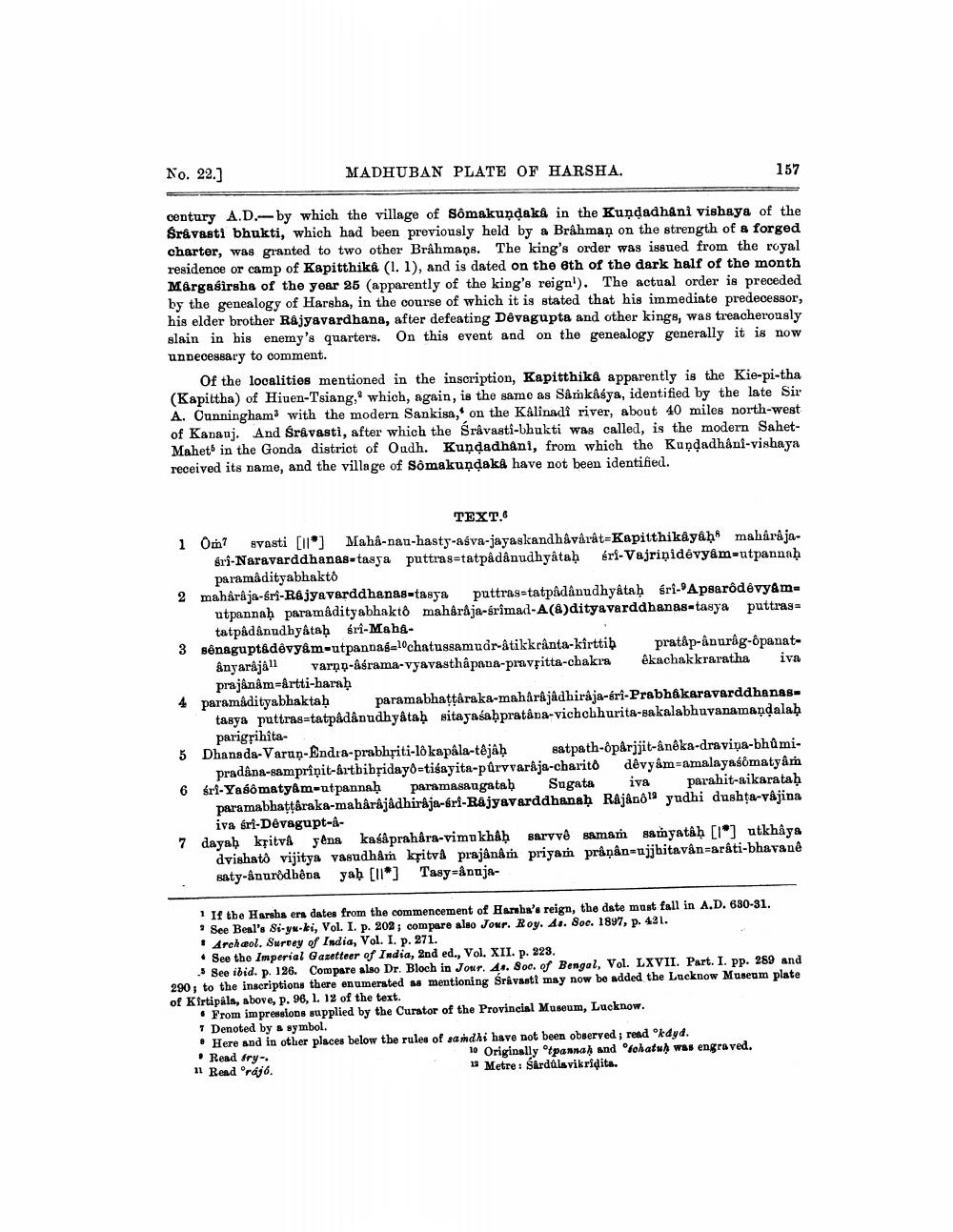________________
No. 22.]
MADHUBAN PLATE OF HARSHA.
157
century A.D.-by which the village of Sômakundaka in the Kundadhani vishaya of the Sråvasti bhukti, which had been previously held by a Brahman on the strength of a forged charter, was granted to two other Brahmans. The king's order was issued from the royal residence or camp of Kapitthika (1.1), and is dated on the 8th of the dark half of the month Märgaśirsha of the year 25 (apparently of the king's reign'). The actual order is preceded by the genealogy of Harsha, in the course of which it is stated that his immediate predecessor, his elder brother Rajyavardhana, after defeating Dévagupta and other kings, was treacherously slain in his enemy's quarters. On this event and on the genealogy generally it is now unnecessary to comment.
Of the localities mentioned in the inscription, Kapitthika apparently is the Kie-pi-tha (Kapittha) of Hiuen-Tsiang, which, again, is the same as Sárkásya, identified by the late Sir A. Cunningham with the modern Sankisa, on the Kalinadi river, about 40 miles north-west of Kanauj. And śråvasti, after which the Sråvasti-bhukti was called, is the modern SahetMahet in the Gonda district of Oadh. Kuņdadhani, from which the Kundadhani-vishaya received its name, and the village of Sômakundaka have not been identified.
TEXT. 1 Om Svasti (11) Maha-nau-hasty-afva-jayaskandhåvárát=Kapitthikâyâh maharaja
gri-Naravarddhanas-tasya puttrag=tatpadánudhyâtaḥ éri-Vajriņidêvyam-utpannaḥ
paramadityabhakto 2 maharaja-bri-Rajyavarddhanas-tasya puttras-tatpadanudhyâtah sri-Apearôdévyam
utpannah paramadityabhakto maharaja-srimad-A(a)dityavarddhanas-tasya puttraga
tatpâdânudhyataḥ śri-Mang3 sênaguptadêvyâm-utpannagelochatussamudr-atikkrânta-kirttib pratåp-anurag-panat
ânyarajali varno-âśrama-vyavasthapana-pravșitta-chakra ékachakkraratha iva
prajânâm=årtti-haraḥ 4 paramadityabhaktaḥ paramabhattâraka-maharajadhiraja-sri-Prabhakaravarddhanas
tasya puttras-tatpâdânudhyâtaḥ sitayaśaḥpratâna-vichchhurita-sakalabhuvanamandalah
parigrihita5 Dhanada-Varun-Endra-prabhřiti-lô kapala-tējah satpath-ôpárjjit-aneka-draviņa-bh û mi
pradâna-sampriņit-&rtbibridayð=tiśayita-purvvaraja-charito dēvy&m=amalayasomatyam 6 sri-Yasômaty&m-utpannaḥ paramasaugatab Sugata iva parahit-aikarataḥ
paramabhattaraka-maharajadhiraja-bri-Rajyavarddhanah Rajánla yudhi dushța-vajina
iva sri-Dêvagupt-A7 dayah kritvå sena kasaprahâra-vimukhaḥ sarvvê sama samyatâh [1] utkhaya
dvisható vijitya vasudhar kļitvi prajânår priyam prânân-ujjhitavân=ar&ti-bhavanê saty-ánurodhêna yaḥ [] Tasy=&paja
1 If the Harshs ers dates from the commencement of Harsha's reign, the date must fall in A.D. 630-31. • See Beal's Si-yw.ki, Vol. I. p. 202; compare also Jour. Roy. 4. 8oe. 1897, p. 491. • Archæol. Survey of India, Vol. I. p. 271. • See the Imperial Gazetteer of India, 2nd ed., Vol. XII. p. 223.
.) See ibid. p. 126. Compare also Dr. Bloch in Jour. 4.. Soc. of Bengal, Vol. LXVII. Part. I. pp. 269 and 290to the inscriptions there enumerated as mentioning Srivasti may now be added the Lucknow Museum plate of Kirtipäls, above, p. 96, 1. 12 of the text.
• From impressions supplied by the Curator of the Provincial Museum, Lucknow. * Denoted by a symbol. . Here and in other places below the rules of sandhi have not been observed ; read kdyd. . Read fry.
10 Originally panna and fohat was engraved. 11 Read raj6.
13 Metre : Śårdalsvikridita.




